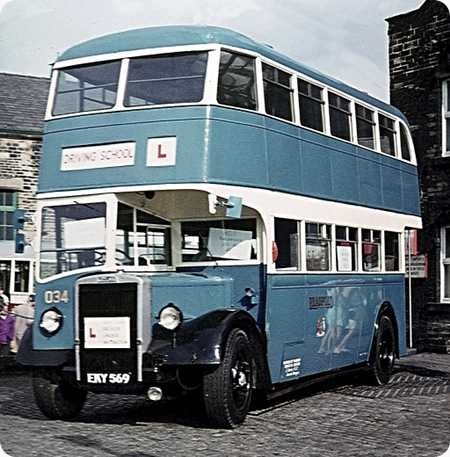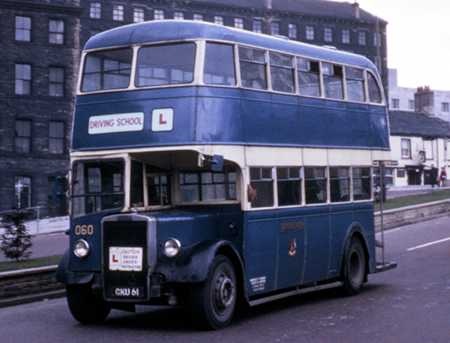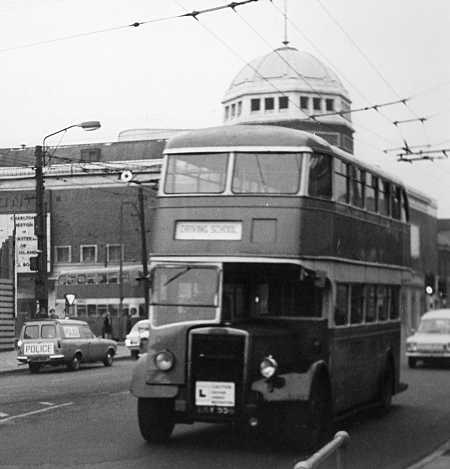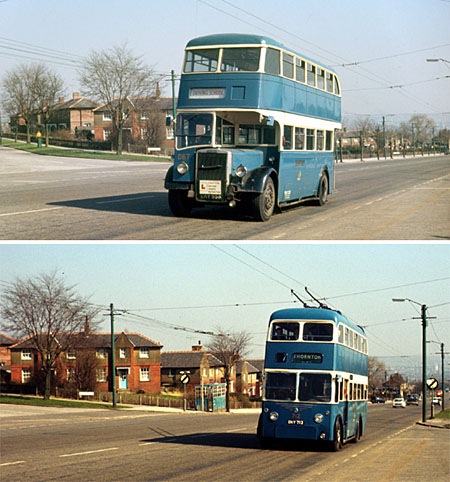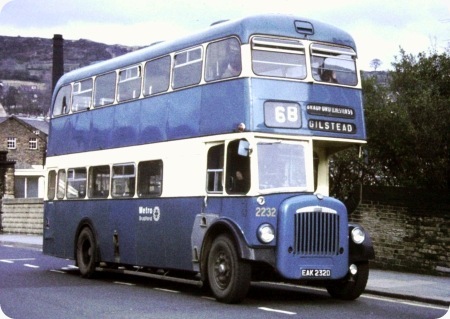Bradford Corporation – AEC Regent III – HKW 82 – 82
Bradford Corporation
1952
AEC Regent III 9613E
East Lancs. H35/26R
The trend for concealing the front ends of halfcab buses underneath what was to often later referred to as a ‘tin front’ was initiated in the immediate postwar period by BMMO with its homemade D5 model. Shortly afterwards, neighbouring Birmingham City Transport decided to follow suit and a different design of their own was hatched which was first fitted to a batch of Crossley DD42’s, but then also to subsequent Daimler CVG6’s and Guy Arab IV’s, giving the three different makes a totally uniform appearance.
It seems likely that Crossley produced this particular design, which became known as the ‘New Look’ – a term then currently in use for the latest Christian Dior womens’ fashion styles. Daimler and Guy then adopted the design as the standard option on their models generally, but no more Crossleys were so fitted. However, Crossley had passed into the hands of the ACV Group, which owned AEC, and around 1952/53 a number of Regent III’s were fitted with the ‘New Look’ front – the customers being Devon General, Rhondda Transport South Wales, Hull and Bradford. However, clearly not wishing their products to resemble Daimlers and Guys, AEC soon got to work on producing a unique design of their own, which first appeared on the Regent V, then later graced Bridgemasters and Renowns, and even a few Regent III’s for Sheffield.
Bradford City Transport 82 was one of a batch of 40 (66-105, HKW 66-105) delivered in 1952/53. Originally H33/26R, they had a couple more seats inserted upstairs in 1957. It is seen here under the trolleybus overhead in Glydegate (which no longer exists) – an extremely short street linking Little Horton Lane with Morley Street opposite the Alhambra Theatre. Just behind on the extreme right is the newly opened Museum of Photography, Film and Television.
82 was withdrawn in 1971, and after a long period in storage was acquired for preservation and magnificently restored by Darren Hunt and Jim Speed. Nowadays it is part of the Aire Valley Transport Collection.
Photograph and Copy contributed by John Stringer
31/03/13 – 08:58
Just a historical puzzler… when was the the National Museum of Photography etc actually opened? After 1971, possibly. It stood empty for a long time, intended I think for use as a theatre. It became known as "Wardley’s Folly" after the City Engineer who planned it. Then the Museum came along, looking for premises, and the rest is history!
In the early 50’s bus bodies got very smart, part possibly of a move to better design inspired by the Festival of Britain. The period piece on this one is the slopey windscreen- a Birmingham hangover?
Joe
31/03/13 – 09:23
It’s my recollection that it was South Wales, rather than Rhondda, which had ‘tin-front’ Regent IIIs. I’ll stand corrected, of course.
An interesting thing about the twelve Devon General examples is that after sale three turned up in West Yorkshire (2 Ledgard, 1 Longstaff) and I believe the Ledgard ones (in their short time with Ledgard, of course) regularly worked into Bradford from Leeds via Pudsey. A further three worked into what was at the time West Yorkshire, from what was Nottinghamshire (with Leon).
David Call
31/03/13 – 12:39
The Museum, now the National Media Museum, opened on June 16 1983. I think John is correct that the tin front came out of Errwood Rd as a result of the collaboration with Birmingham. There are a very few minor changes, just as Leyland tinkered with the BMMO design for its tin front.
Phil Blinkhorn
31/03/13 – 12:40
You’re right David of course, it was South Wales and not Rhondda – I don’t know where that came from !
I remember both the Ledgard and Longstaff’s ex-Devon General AEC’s, I rode on all three and they were most wonderful buses – especially in the sound effects department as I recall. The Longstaff one’s aural delights were a little stifled though, as following a brief blast up Webster Hill out of Dewsbury it was never really able to proceed beyond a steady amble around the back lanes of Ravensthorpe and Northorpe.
John Stringer
31/03/13 – 17:45
David – sorry to be pedantic – it was not West Yorkshire (a 1974 invention) but the good old West Riding of Yorkshire – later to become (in that area) another 1974 invention – South Yorkshire.
The old West Riding was vast, stretching from Goole in the East to Bentham and the outskirts of Lancaster in the West and from the area you describe in the South to Dent and Sedbergh in the North
Gordon Green
31/03/13 – 17:46
As an eleven year old schoolboy, I remember with great excitement when some of these first "new look" AEC Regent IIIs entered service on the 1 November 1952. These were the first true "Humpidge" buses after prior taste of C T Humpidge influence with the Crossley re-bodied trolleybuses that had appeared in the previous March. I can confirm that the "tin fronts" were made and fitted at Crossley Motors at Errwood Park. I do recall seeing the final 15 chassis (91 -105) with "tin fronts" stored in the Tin Sheds at Thornbury as these buses entered service later in 1953.
These final 15 buses did differ in appearance to the previous 25 (66 -90) buses as these were the first to have a blue roof in place of the mid grey which was the style used by the previous General Manager C R Tattam.
Richard Fieldhouse
01/04/13 – 07:50
The ‘new look’ or tin front certainly made buses so adorned look much more modern in comparison to those fitted with traditional radiators. Rochdale had a batch of Regent III’s fitted with virtually identical East Lancs bodies dating from 1951 but they had the traditional AEC exposed radiator and looked to be from a different generation than the Bradford vehicles despite being only two years older.
I always found it interesting how the two adjacent Yorkshire cities of Bradford and Leeds had markedly differing vehicle policies. Bradford went early on for tin fronts and then froward entrances on the large fleet of Regent V’s while Leeds ploughed the traditional furrow with 7’6" wide buses until the 30 footers came, exposed radiators and rear open platforms for many years. The small batch of forward entrance Daimler CVG6’s bought by Leeds was I understand due to persuasion from Bradford to run forward entrance buses on the joint Leeds-Bradford route.
Philip Halstead
01/04/13 – 07:51
If my memory serves me correctly, Glydegate was the last road in the UK to be newly wired for trolleybuses coming after the final Teesside extension. It served to allow inbound trolleybuses from Wibsey and Buttershaw to cope with road works and lasted until later in 1971 when the services were withdrawn.
Ken Aveyard
01/04/13 – 07:53
Richard – I well remember these vehicles as from new they were the mainstay of services 79 & 80 (Heaton & Little Horton via Heaton) and I used them daily to School. (One old penny half fare from Heaton to Lister Park Gates !)
I always suspected that these new vehicles were so allocated for two reasons – one being that Heaton in those days was ‘posh’ (I wasn’t) and secondly Chaceley Humpidge lived in Heaton where he was a lay preacher at my local Church.
A couple of years ago I renewed my acquaintance with 82 (which each year provides a shuttle bus service in Haworth for the annual ‘Forties’ war re-enactment weekend) by taking ride. Nostalgia indeed.
Gordon Green
01/04/13 – 07:54
Liverpool had some Regent IIIs with Crossley bodies with this radiator fitted.
Jim Hepburn
01/04/13 – 07:58
An interesting sidelight arises from Richard’s post and my earlier one on this thread. He refers to Errwood Park, I refer to Errwood Rd.
When Crossley originally bought the site it was referred to as Errwood Park, though its location on the Stockport side of the boundary is across what is now Crossley Rd from Errwood Park which still exists and is in Manchester. In those days Crossley Rd was an un-named thoroughfare dividing Cringle Fields from Errwood Park and crossed the boundary between Stockport and Manchester, leading from Stockport Rd at Lloyd Rd to Errwood Rd itself.
The Crossley site, bounded by the railway line and Cringle Fields, which eventually became a large number of football pitches on which I played many a match on a cold Sunday morning, was originally part of Cringle Fields a piece of open grazing land between Errwood Rd and the railway, so it may be assumed that Crossley wanted to give some elegance to their address after leaving the very industrial sounding Pottery Lane, Gorton and Cringle Fields sounded too agricultural whereas Errwood Park was more reminiscent of a country park!
Most people I was brought up with in the adjacent area of Heaton Moor referred to Crossley’s Errwood Rd, though there was no entrance from that thoroughfare without traversing Crossley Rd! Fairey Aviation and later Fairey Engineering which occupied the site at various times always referred to it as Heaton Chapel Works, as did Stevenson’s Box Works who moved in after Crossley closed, Heaton Chapel being the suburb of Stockport in which the works was located.
I wonder if the Errwood Rd usage was actually put about by Crossley whose very existence in the bus world was so dependant on Manchester’s patronage in the 1930s as Errwood Rd was in Manchester whereas the boundary between Manchester and Stockport ran along their wall built to divide the factory from the rump of Cringle Fields, Manchester.
A 1970 copy of the Manchester A-Z interestingly shows the site all within Stockport with Errwood Park Works shown as the major part of the site yet the site where most buses were built is shown still as "Motor Car Works"!
Dig the bones out of that.
Phil Blinkhorn
02/04/13 – 08:17
Philip H makes a good point about the divergent vehicle policies of Bradford and Leeds.
I think I’m right in saying that Leeds had Regent Vs, but with exposed radiators. Why on earth would an operator wish to remove such a graceful and well proportioned front end to revert to the ‘old fashioned’ look of an exposed AEC radiator. Nothing wrong with the exposed AEC rad, but surely it had had its day by the time the Regent Vs came along.
Petras409
02/04/13 – 08:17
The Liverpool Regent IIIs that Jim H refers to certainly had concealed radiators, but while the grille was identical, the front end design was completely different, using a full-width flat front, as seen in this view of A40. www.old-bus-photos.co.uk
Alan Murray-Rust
02/04/13 – 08:18
The Liverpool Regent III’s had a different tin front unique to Liverpool. It was virtually a full width bonnet and incorporated the front mudguards more on the lines of the Leyland BMMO front than the Birmingham design. There’s a picture of one of the Saunders-Roe bodied buses with this front under the Liverpool link on this website.
Philip Halstead
02/04/13 – 08:19
Ken, Somewhere in my mind is the idea that Glydegate was the last public highway in the UK to be wired for trolleybus operation. The road layout at this point was a gyratory: Little Horton Lane between Princess Way and Glydegate was one way from Princess Way, and Morley Street was one way from Glydegate to Princess Way. Glydegate acted as the road connecting the top of the one-way sections of Little Horton Lane and Morley Street.
According to Stanley King’s book ‘Bradford Corporation Trolleybuses’ Glydegate came into use on 18 May, 1969. The shot of number 82 on service 11 to Queensbury must have been before 1 March 1971 when the services were recast and the joint services to Halifax came into operation.
Kevin Hey
02/04/13 – 12:08
Leeds stuck with exposed radiators until the manger changed in 1961 this was due in some part to ease of maintenance. After that all buses were tin fronted or rear engined Philip mentions the front entrance Daimlers these 5 buses were considered so non standard they were offered for sale in the late sixties In the event they hung on to be the only Leeds buses to be allocated to all four divisions of the PTE and the only front engined Leeds buses to wear PTE livery 574 has been restored and often appears at rallies.
Chris Hough
02/04/13 – 13:03
There is a picture on this site of a Doncaster Regent 5 looking like a 3 with exposed radiator. They stuck with them, too the last front engined Titans in the mid 60’s had exposed radiators like the recent Stockport posting. I think it was also a sort of macho thing like Atkinson lorries.
Joe
02/04/13 – 14:50
The use of exposed radiators was by no means a "macho thing". Proponents of the exposed radiator point to easier maintenance access, better driver visibility and better cooling, so much so that when Daimler insisted it would not provide exposed radiators and Manchester was not impressed with the tin front offered, it eventually designed its own concealed radiator for its Daimlers which was all but a reversion to the dimensions of the exposed radiator and was such a success that it was adopted by the manufacturer as its standard.
Phil Blinkhorn
02/04/13 – 14:50
I stand corrected over the Liverpool Regent IIIs. Well it is over 50 years since I’ve seen one!
Jim Hepburn
02/04/13 – 16:34
I still reckon an exposed radiator was seen as a proper "man’s bus" (I’m talking in the unliberated past!) like an Atkinson or a Mack and pretty fronts went with heaters, power steering, trafficators and no climbing into the cab. (Remove tongue from cheek)
Joe
02/04/13 – 17:58
I agree with Joe – tin fronts = mutton dressed up as lamb if you ask me!
Stephen Ford
03/04/13 – 07:50
There doesn’t seem to be that much (anything?) on Glydegate at the time the photograph was taken! For the past few years I’ve driven past a similar street in Bradford, which amounted to no more than a left-turn slip road at a set of traffic lights – no buildings on either side – but retained its street name. I think Chester Street (of WYRCC bus station fame) may still exist in this sort of vestigial format – though I’m not certain that the name remains.
From the first time I saw one I always thought that there was "something" about the Manchester-fronted CVGs of Bradford and Huddersfield (Leeds was unexplored territory in those days!): as much as I tried to stay loyal to AEC/Hebble I still have to admit that – much like Clodagh Rogers – those Manchester-fronted CVGs looked classy.
Halifax? Sorry, your exposed-radiator PD2/3s didn’t even get a look in . . . you should have stuck with Regent Vs – attractive enough in the Susan George mold, but not a patch on Clodagh! And I still can’t work out whether the
St Helens front on Bradford’s PD3s was "industrial" or just plain ugly – like, like . . .
Anyway, for Glydegate to be able to claim that it was last road to be wired for trolleybus operation seems to be stretching things for was by then just part of a gyratory system.
Philip Rushworth
I have very fond memories of conducting 82 even though I never had the pleasure of working for BCT. "Well then what’s he talking about" you may understandably ask !!
This superb vehicle played a welcome and major part in the 40th anniversary commemoration running day on 14th October 2007 marking the sad end of the Samuel Ledgard era. The fifteen hour running extravaganza culminated in a simulation of the 23:00 hours departure from Leeds to Ilkley via Guiseley – a journey performed very appropriately by the preserved Bradford RT – the real thing forty years earlier featured HLX 157, a Ledgard RT, which ran out of fuel a mile short of the Ilkley terminus. That circumstance, unheard of normally in Ledgard days, remains a mystery to this day. The Bradford RT was made to simulate a similar failure at the same spot. In 1967 the RT was replaced by Ledgard’s own 1953 U, a Mark V Regent, but in 2007 Bradford 82 played the part having "been summoned from Otley depot." So there we have it, 82 completed the journey to Ilkley and then operated the late running 2355 from Ilkley to Otley. I had been conducting all day from 09:00, mainly on the superbly restored MXX 232 (RLH 32) so very kindly provided in perfect Samuel Ledgard livery by Timebus of St. Alban’s. The feeling of "deja vu" in that last couple of hours was almost unbearable, but nevertheless I felt very honoured to be asked to do it, wearing my genuine Ledgard uniform and using an actual Otley depot Setright which I own.
Chris Youhill
03/04/13 – 11:43
I always considered Hull’s "tin-fronted" Weymann bodied AEC Regent IIIs (336-341) to be the city’s best looking buses until the dual door Atlanteans came along in 1969. The overall body profile combined with the typical upswept bottom panels and the front end resulted in a very handsome bus one of which can be seen here.
Malcolm Wells
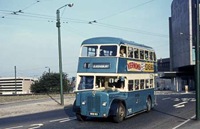 Vehicle reminder shot for this posting
Vehicle reminder shot for this posting
05/04/13 – 05:48
This discussion makes me wonder if there would ever have been such a thing as a tin front if it hadn’t been for Midland Red uniquely combining the roles of chassis designer, body designer and operator. Being in the vanguard of underfloor-engined development, which revolutionised the appearance of single deckers, it was probably inevitable that they would do something with their double deckers as well. Then I suppose BCT, seeing all these modern apparitions coming in and out of their city, felt obliged to keep their end up by doing something similar, and it all took off from there.
I remember being very impressed as a youngster with the tin-fronted PD2s of Oldham and Southport. But ultimately, as so often happens, something which was designed specifically to create an appearance of modernity in its own time ends up rapidly becoming very dated.
Peter Williamson
Quick links to the - Comments Page - Contact Page - Home Page

